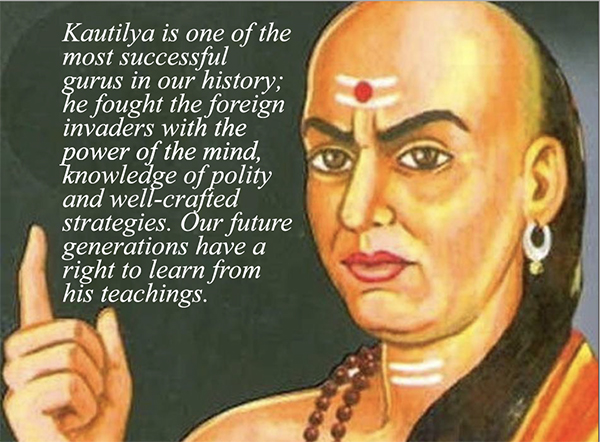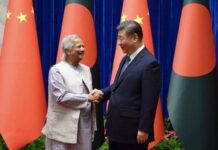The Possible Future Improvisations
There is a long history of politics and strategic moves behind the continuing validity of fascination for the Western world in Asia. We will have to see how, with unnatural ease, India and Japan both have accommodated many of the values and lifestyle patterns of the West in their social-cultural behavior while at the same time, they see difficulties in overcoming the mindset gap between themselves.
This year, the Indian Ministry of External Affairs (MEA) has set up the New and Emerging Strategic Technologies (NEST) Division because a realism-based approach tells that, no matter how sharp the mind of Kautilya or edgy the sword of Samurai is, to win in the realities of the 21st Century, they will have to embrace the power of emerging technologies.
Special Moves
In the book ‘The Art of War’, Chinese military strategist Sun Tzu wrote: “Do not repeat tactics which gained you victory in the past but let your tactics be modeled by the infinite variety of circumstances.” These words summarize the popular approach of the power players and the Internet has added more variations to this. Today, to conquer a country or to damage its morale, the physical movement of the troops is not necessary as the sieges of narratives (through digital and social platforms) are proving more effective. In such an environment, can we afford to continue pursuing a straight and traditional approach to defending our interests and priorities? Both countries will have to seek their answers soon.
In the Special Strategic and Global partnership of India and Japan, the Government to Government (G2G), Government to Businesses (G2B) and Business to Business (B2B) exchanges are going well but it is our People to People (P2P) exchanges that need a serious push.
Joint Production of Video Games
The Japanese sword saint Musashi wrote “When you have attained the Way of Strategy there will be not one thing that you cannot understand” and “You will see the Way in everything.” Japan is known for its world-class video game industry and the country should be applauded for keeping the spirit of its Samurai warriors alive, in the minds of young Japan through video games/animation characters. From the Way of Samurai (2002) to Ghost of Tsushima (July 2020) Japan has a track record of consistent perfection in producing strategy, action and adventure games. Today, a majority of Japanese youth follow the Western lifestyle/trends but, at the same time, they enjoy the Samurai spirit, too.
An Idea that needs to be developed
The reach and influencing power of technology is real and the two technologically advanced nations like India and Japan will have to start exploring the possibilities of leveraging these capabilities for enhancing the bond between our people.
WYSIWYA Strategy
In computing, the What You See Is What You Get (WYSIWYG) approach has dominated the system designs for many years. Today, we will have to think about designing our strategy with ‘What You See is What You Aim (WYSIWYA)’ kind of approach.
How will kids, who are growing up seeing Superman/Spiderman (and now Avengers), believe that the problems of the Earth can be solved by the Kautilyan approach and Samurai spirit, too? For Kautilya and Samurai to capture the imaginations of our kids, the Japanese video game developers will have to join hands with the Indian technical creative community. Together, the two can design artificial intelligence (AI), virtual reality (VR) and simulation-powered game series, in which, say the two animation characters – a Guru (Kautilya) and a Warrior (Samurai) – can be shown working on a joint mission, such as defending the ancient treasure, culture and other civilizational assets of the region. And they can be shown applying a combination of manoeuvres involving mind, strategy and the spirit of swordsmanship (in well-defined levels of the game). Such close to real-life experiences will make our kids comprehend how the finest minds of the two sides can work together.
ALSO READ: INDIA-JAPAN: A Dependable Partnership
It is certain that the 21st Century smartphone generation cannot grasp the ideas through text and books are not enough to satisfy their curiosity and creative hunger. With the production of such video games, the complex ideas of Kautilya’s Arthashastra, i.e., the elements of sovereignty, six-fold foreign policy (Rajamandala theory), Peace and Wartime scenarios, Adoption of Double policy, marching with the combined powers, different vices and calamities scenarios of a nation, acts of an invader and powerful enemies, consideration about an enemy in the front and rear, strategic means to capture a fortress and secret means to protect the state kind of ideas can be introduced in a simple and understandable way. Kautilya is one of the most successful gurus in our history; he fought the foreign invaders with the power of the mind, knowledge of polity and well-crafted strategies. Our future generations have a right to learn from his teachings.
These moves, when planned on a large scale, can give a much-needed boost to the Japanese video game industry too, which is facing some difficulties since the last few years. With the growing interest of Chinese and American investors in video game markets, it seems that this industry in Japan is struggling with a similar “iPod/iPhone shock” that electronics/mobile phone companies have gone through. Japan’s domestic video game developers, who were once leading the ‘golden age of video game industry’, are now left with only two choices – either adopt the Western ideas/strategies or directly join hands with the foreign producers. Since the last few years, there have been talks regarding the revival of the Japanese video game industry, while the major Japanese video game companies (the leaders of the industry in the past) are selling their stakes to foreign investors. But, at the same time, a community of indie developers (independent video game developers) and hobbyist is also taking shape in Japan, on which hope rests.
The idea of the joint production of video games portraying the Kautilyan approach and Samurai spirit can not only give a different kind of boost to this bilateral partnership but is also productive in the commercial sense.
Superheroes are replacing Samurais
According to the 2015 report of Parrot Analytics (a media analytic firm), Gotham, Arrow, Agent of S.H.I.E.L.D, The Flash, Supergirl, Daredevil, iZombie, Constantine, Ultimate Spiderman and Agent Carter are the top ten most in-demand superheroes in Japan. Gradually, the tricky acts of Daredevils, Spiderman, Supergirls and Agents are replacing the sagas of Samurai Warriors in the land of Samurais. India is in a quite worse position here, we have not provided anything beyond Captain Vyom, Shaktimaan and Baalveer to our kids and now we have a whole generation growing up watching the fantasies of Captain America, Superman, Batman, Hulk, Thor, Wolverine and Ant-Man kinds of conceptions. From the long-term perspective, with the continued absence of an image about our heroes, we will not be able to instill the winning spirit in our future.
The Participation of Women Power
During prime minister Narendra Modi’s first visit to Japan in September 2014, Japanese prime minister Shinzo Abe shared his vision of achieving a society in which the women can shine and he said that in this Japan must advance the cooperation with India. Modi echoed the sentiment and he also proposed the idea of establishing a parliamentary association of Indian and Japanese women. The active participation of women from both sides could give a much-needed push to people-to-people (P2P) exchanges.
In the social-cultural environment there are several similarities between the Indian and Japanese women while in the religious context, India and Japan worship the same goddesses with different names such as Maa Saraswati, who is recognized in Japan as the goddess Benzaiten and Maa Laxmi as the goddess Kichijoten. Our women can add the elements of desire, dedication and depth to the vision of the two countries, which is crucial at this stage. To shape their engagements, a Joint Women Forum can be initiated which will act as a platform to represent the voice of the Asian women at large. Unlike other women forums, here the participants will not restrict their discussions to their community issues alone, rather the women of India and Japan will discuss the broader vision related to national interests and how Asian societies can come closer at different levels.
Later, the women belonging to different walks of life and from other ASEAN members can also be encouraged to take part. When women come together, families and societies will naturally draw closer.
Traditional Sector
In traditional sectors, the current status of India-Japan’s Special Strategic and Global Partnership can be defined with three Ds – Dialogues, Delegations and Deliberations. In the recent exchanges between the foreign ministers of India and Japan, on the sidelines of the Quad meet, some encouraging developments have taken place, such as the finalization of the Memorandum of Cooperation in Cyber-security and discussions regarding the expansion of this bilateral partnership in third countries.
Space Technology
In the Space technology domain since 2012, talks regarding joint missions have been underway and some of these concluded with the finalization of joint missions such as ISRO and JAXA’s joint Lunar Polar Exploration Mission (LUPEX), which is expected to be launched in the next 3 to 4 years. In March 2019, the India-Japan Space Dialogue was held in Delhi, in which the delegations consisting of security and space department representatives participated. In 2018, during his Japan visit, Modi initiated the inter-governmental discussions around it and, a few months back, an India-Japan joint study group was formed to explore the technicalities related to the joint lunar mission.
ALSO READ: INDIA-JAPAN: Immense Potential in Post-Covid Partnership
The developments on such joint space missions will carry on at their pace but in parallel to those moves, the two countries can initiate some knowledge exchange activities between the young space enthusiasts of both sides. India has a rich heritage of astronomical discoveries and ancient Indian astronomy is still a matter of research across the world. For centuries, with a consistent curiosity, the Western world and their dedicated faculties are exploring the advanced astronomical findings of ancient India (which are often called the most precise documents of space-related computations). But India never promoted such curiosity among its Asian allies.
To make our kids look beyond NASA and sci-fi movies, the two countries can set up a forum where the young minds (preferably from secondary schools and colleges) would gather and get themselves familiar with the great ancient Indian astronomers and mathematicians like Aryabhata, Varahamihira, Bhaskara, Brahmagupta, Parameshvara, Madhava of Sangamagrama, Sankara Narayana, and Govindasvami and others. Such forums can meet frequently to explore subjects such as the Aryabhata’s ‘Aud Ayaka system’, or Varahamihira’s Pancasiddhantika, Surya-Siddhanta, Vasishtha Siddhanta, and Vishnudharmottara Purana and many other ancient Indian astronomical texts.
There is a general conception that there is no ancient constellation mythology in Japan but Japanese authors like Takashi Katsumata have challenged this notion with various evidences from the Kojiki (Records of Ancient Matters, 712) and the Nihon Shok (The Oldest Chronicles of Japan, 720) in their papers/ books. Several different interpretations of stars exist in Japanese culture and Japan has produced many brilliant astronomers too. Their discoveries and findings will encourage young minds. This culture, once initiated by India and Japan, can be promoted with other ASEAN partners.
Cyber Security
Similar to space technology, cyber is another area where cooperation talks have been going on for long. In February 2019, the two countries conducted the fourth cyber dialogue. Earlier, in 2012, 2017 and 2018, similar exchanges had taken place mainly centered on knowledge/experience sharing, risk resolution and prevention. It is quite unusual that in cyber security-related interactions between India and Japan, due emphasis has not been given to any proactive measure for the serious cyber challenges that the two countries are facing. The frequency of our cyber exchanges is similar to that of the space domain, only the size of delegations becoming more diverse and large each time.
We need to understand that the security of the critical infrastructure is crucial for a nation. An attack on the critical infrastructure can cause much more severe damage than any conventional terror attack can. Japan is one of the most active partners of many of our critical infrastructure projects and it will be an added advantage if we cooperate in their security. In the recent India-Japan foreign ministers’ Strategic Dialogue, both sides have finalized the text of the cyber security agreement, for promoting cooperation in capacity building, R&D, security and resilience in the areas of critical information infrastructure, 5G, Internet of Things, AI, among others. We need to add active industry participation in cyber security exchanges that can help in evolving some concrete measures.
There are other important sectors of cooperation such as naval engineering, biotech, medicines/pharma, solar energy and the possibility of merging Japanese hard power (electronics/computing parts) with Indian soft power (software system/services) to produce future-oriented products, etc.
The only test of the India-Japan partnership is to end the legacy of hesitation, doubt and unfamiliarity, as Modi often says that “Our past has desired us to stand together. Our present is encouraging us to work together.”
(Note: The first part of this article “India and Japan Can Show the Right Path” has been published in the Sep 2020 issue).



















[…] INDIA-JAPAN: Kautilyan Approach and Japan’s Samurai Spirit – Part II […]